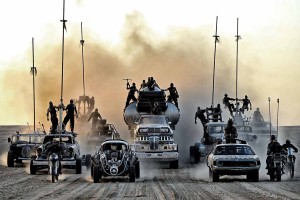![]()

“George was going to be away for at least eight months shooting in Namibia and as we have two teenage sons together, I was concerned that I might not have enough hours in the day. And I wondered if it was a good idea for a husband and wife to work together. George was very insistent and persuasive, so after much internal debate, I decided to jump off the proverbial cliff and see where I landed. And honestly, the moment the first footage came in – it was the opening scene of Max in the desert eating the lizard and being chased by war boys, I was hooked.”

 Some of the more challenging aspects of Sixel’s job were how to balance the various action scenes with the quieter moments. “And how long could you sustain any one sequence before the audience was worn out? One of our test audience criticisms was that there was ‘too much action.’ So this required a careful paring back of set pieces. The sequence where Max and Furiosa fight off the Rock Riders in the canyon was at least twice the length. We lost some great footage here, but that’s what happens on all films. For a long time it looked like the first act was going to eclipse the final chase back to the Citadel. There was no way we could allow that to happen.” Ironically the scene the crew fiddled with to the bitter end was a dialogue scene, in which Max, Furiosa and the Vuvalini decide to return to the Citadel. They rewrote some dialogue and Sixel used existing footage. She relayed that she had to slip it in as seamlessly as possible.
Some of the more challenging aspects of Sixel’s job were how to balance the various action scenes with the quieter moments. “And how long could you sustain any one sequence before the audience was worn out? One of our test audience criticisms was that there was ‘too much action.’ So this required a careful paring back of set pieces. The sequence where Max and Furiosa fight off the Rock Riders in the canyon was at least twice the length. We lost some great footage here, but that’s what happens on all films. For a long time it looked like the first act was going to eclipse the final chase back to the Citadel. There was no way we could allow that to happen.” Ironically the scene the crew fiddled with to the bitter end was a dialogue scene, in which Max, Furiosa and the Vuvalini decide to return to the Citadel. They rewrote some dialogue and Sixel used existing footage. She relayed that she had to slip it in as seamlessly as possible.
 There was a danger that the movie would be perceived as one long car chase, but a great deal of emotional involvement was already clear in the screenplay. Sixel explained, “We constantly did passes of the film where we only looked at Max and examined each moment in the light of his character. We did the same for Furiosa, Nux and the Girls. We kept moving pieces of the jigsaw puzzle around, adding, subtracting until it fell into the best possible place. It was a juggling act keeping them all ‘alive’ in the final chase.” The live stunts are truly impressive, but the audience is invested in who lives or dies in the story. We want what the protagonists want, which is often underserved in major action movies.
There was a danger that the movie would be perceived as one long car chase, but a great deal of emotional involvement was already clear in the screenplay. Sixel explained, “We constantly did passes of the film where we only looked at Max and examined each moment in the light of his character. We did the same for Furiosa, Nux and the Girls. We kept moving pieces of the jigsaw puzzle around, adding, subtracting until it fell into the best possible place. It was a juggling act keeping them all ‘alive’ in the final chase.” The live stunts are truly impressive, but the audience is invested in who lives or dies in the story. We want what the protagonists want, which is often underserved in major action movies.
This little job, that Sixel was so hesitant to sign on to took nearly two years. In her defense, she pointed out, “Yes, I know that sounds like a long, time but for more than a year after the shoot had wrapped, we had no opening or closing scenes. Once we had that in the can, only then could we judge the film accurately and make adjustments. And besides, we had 480 hours of material. That alone takes about 3 months to watch before you can even do anything with it.” In the end, this project was the ultimate Rubik’s Cube of a movie for Sixel. There were over 2,700 shots in the final version. A huge number of decisions. “The fact that it all amounted to something and that the film was well received, that’s something to be proud of. Good to know that one is not completely deluded.”





